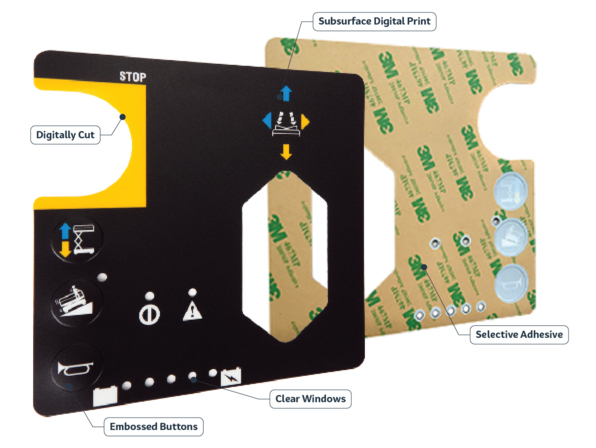How Custom-Printed Graphic Overlays Boost User Experience and Awareness
How Custom-Printed Graphic Overlays Boost User Experience and Awareness
Blog Article
Comprehending How Graphic Overlays Work to Enhance Your Creative Jobs
Graphic overlays serve as an essential element in the world of innovative projects, enhancing both aesthetic communication and audience engagement. The effective assimilation of these overlays needs cautious consideration of layout concepts and objectives.
What Are Graphic Overlays?
Graphic overlays are visual components that are positioned on top of a base picture or user interface to improve interaction and customer experience. They serve various functions, consisting of giving extra details, assisting user communication, and enhancing visual charm. Typical applications of visuals overlays can be located in digital user interfaces, marketing, and educational materials.

Graphic overlays are usually created utilizing design software application, allowing developers to control transparency, color, and dimension to achieve the wanted result. Recognizing just how to efficiently implement visuals overlays is important for designers intending to raise their imaginative jobs.

Benefits of Using Graphic Overlays
Using visuals overlays can dramatically boost the performance of visual communication throughout numerous tools. One of the main advantages is the capacity to share complicated details succinctly. By layering graphics, message, and photos, overlays help with the discussion of information in an extra absorbable format, making it much easier for audiences to understand key ideas swiftly.
Furthermore, visuals overlays can boost visual appeal, drawing focus to particular aspects within a design. This is particularly useful in marketing and advertising, where capturing the audience's rate of interest is vital. The strategic use of shades, forms, and typography in overlays can develop a interesting and cohesive aesthetic narrative, boosting brand recognition.
In addition, graphic overlays offer flexibility in layout. They enable makers to adjust material for various systems without beginning from scratch, ensuring uniformity across numerous channels. This adaptability is important in today's digital landscape, where content should be optimized for varied tools and styles.
Sorts Of Graphic Overlays
When thinking about the different types of graphic overlays, it is important to identify their varied applications across various industries. Graphic overlays can be categorized mostly right into three types: functional, decorative, and informational.
Practical overlays are developed to improve the usability of an item. Generally discovered in digital tools, these overlays frequently supply tactile responses with increased switches or textured surface areas, boosting individual communication. They can additionally serve as a protective site layer, securing the underlying parts from wear and tear.
Ornamental overlays focus on visual enhancement, permitting brands to express their identification through lively styles and personalized graphics. These overlays prevail in packaging, advertising and marketing, and point-of-sale materials, where visual allure is critical for bring in consumers.
Educational overlays, on the other hand, are used to convey crucial data or instructions. They can be seen in applications such as signage, customer handbooks, and training graphics, where clarity and readability are paramount.
Each kind of visuals overlay serves an one-of-a-kind function, adding to the general performance of innovative jobs while resolving certain needs within numerous industries. Understanding these differences is essential for choosing the appropriate overlay for your task.
Ideal Practices for Implementation
To guarantee the effective implementation of graphic overlays, it is important to establish a clear understanding of the project's objectives and the details demands of the end-users. Begin by conducting detailed study to recognize the target audience and their preferences, as this will notify style options and performance.
Next, create a comprehensive plan that details the overlay's function, format, and combination procedure. This strategy ought to include individual interface considerations, making sure that overlays boost instead of block the individual More about the author experience - Graphic Overlays. Take into consideration the visual pecking order and maintain consistency in design aspects, such as shade fonts, symbols, and systems, to promote brand name coherence
Checking is essential; collect comments from a depictive sample of individuals to identify prospective problems and areas for improvement. Iterate on the style based upon individual input and efficiency data. Additionally, ensure compatibility across various gadgets and platforms to optimize ease of access.
Tools for Producing Overlays
Creating efficient graphic overlays calls for the right tools to equate layout Web Site concepts into useful applications. Various software and systems are available, each tailored to details demands and ability levels.
Adobe Photoshop and Illustrator are industry requirements, supplying substantial capacities for developing and manipulating overlays. These devices give advanced functions such as layer administration, mixing settings, and vector graphics, making it possible for developers to produce intricate and high-grade overlays.
For those seeking a more straightforward strategy, Canva and Figma are outstanding choices (Graphic Overlays). Canva's user-friendly interface allows users to create overlays rapidly making use of pre-designed design templates, while Figma facilitates collaborative design in real-time, making it optimal for groups
Additionally, open-source choices like GIMP and Inkscape provide durable functionalities without the associated prices of proprietary software program. These tools enable versatility in layout and can suit various documents layouts, making certain compatibility across different platforms.

Verdict
In verdict, graphic overlays serve as effective devices for enhancing creative projects by supplying visual clearness, visual appeal, and brand uniformity. By comprehending the fundamental concepts and benefits connected with graphic overlays, makers can substantially boost the quality and efficiency of their visual communications.
Graphic overlays serve as a pivotal element in the world of innovative projects, enhancing both aesthetic communication and target market interaction.Graphic overlays are typically produced using style software, permitting developers to adjust size, openness, and color to achieve the desired impact.Additionally, graphic overlays can boost aesthetic charm, drawing attention to particular components within a style.In addition, visuals overlays give adaptability in design.In conclusion, visuals overlays serve as powerful devices for boosting imaginative projects by offering visual quality, visual appeal, and brand name consistency.
Report this page